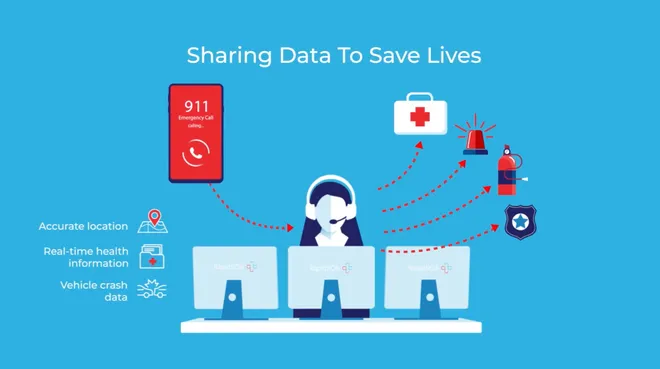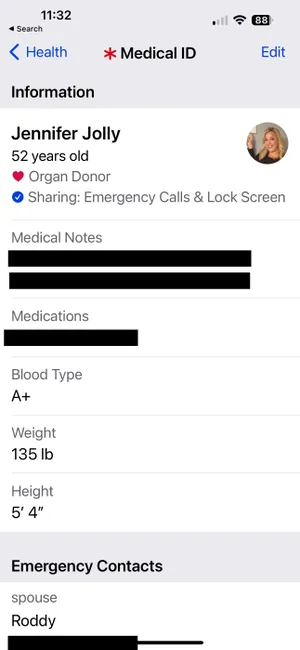SOS! Here's how to set your phone's emergency settings and why it may be a life-saver
"I have really done it now," I thought as I felt my right ankle explode after jumping away from a spooked horse in the woods near my house. I was rounding up my aunt and uncle’s handful of horses for their evening feeding and their two young, rambunctious Irish Setters chased a deer right through the middle of the herd and sent us all scrambling.
No big deal. It happens. I just needed to throw myself out of everybody’s way with a crude sort of jump-hop-turn ninja move, which did not go as planned. My body landed in one direction on a rotting log while my ankle went the other way.
"Stay calm," I thought. I dig my phone out of my pocket and hope for a signal. But I was a good quarter mile from the barn on the outskirts of a field accessible only through unmarked trails in the woods. I had zero clue how to tell anyone where to find me.
Amazingly though, I didn’t have to. I didn’t even really have to make a 911 call at all.
My Apple Watch detected a fall, and my phone was just one “Hey Siri, call 911” voice prompt away.
But the part I didn’t know before this experience is that every iPhone, Apple Watch, and even most Android phones can now connect directly to emergency responders −and show them your location within a few feet − through a next-gen 911 platform called RapidSOS.
That’s huge. Not only are new features such as fall and crash detection now saving people’s lives, but having the ability to pinpoint your location in real-time is one of the most significant and widespread tech upgrades I’ve ever run across with impacts that are − quite literally − saving people’s lives.
“In 2020, a million people died during an emergency,” RapidSOS Co-Founder and CEO Michael Martin told me over Zoom. “[This problem] has had profound consequences on human life, and we knew we could do better.”
Can 911 track your location on a cell phone?
While location services on our devices evolved to bring us Uber, Grubhub, and annoyingly targeted advertising, our 911 system stalled in the tech equivalent of the Stone Age.
It was designed in the 1960s for a landline phone call over a hard-wired connection, back when phones only plugged into your wall at home and came with a rotary dial or push-buttons the full size of your fingertips.
Until recently, 911 could not accurately track cell phone calls because they were routed to the nearest cell tower, not to your actual location. Sometimes you were lucky if it was just a few miles away, but it could end up in another state or even another country altogether.
Earlier this year, House members introduced legislation to speed up a national upgrade to the entire 911 system. It’s called the Next Generation 9-1-1 Act of 2023, and would provide $15 billion to help local 911 call centers fund their upgrades to an advanced suite of technologies that can handle photos, video, text, and seamlessly forward calls.
The goal is to upgrade all 911 centers to support this new wave of deeper technology and data − so they can support the full suite of available features from RapidSOS and others.
How does RapidSOS work?
In the meantime, RapidSOS, along with deep collaboration with emergency responders worldwide, is ten years and a quarter of a billion dollars ahead of the game. It’s currently in some 500 million digital devices and apps and 97% of 911 call centers in America.
“Last year, 165 million calls went through RapidSOS. We peaked at 550 per second during New Year's Eve. But we’re only starting to scratch the surface,” Martin said.
So, what does it do, exactly? RapidSOS is like a connector, or an API (application programming interface) in tech-speak, that uses cloud communications and data analytics to funnel essential information, including your exact location, from your device to the nearest 911 emergency center.

“When an emergency occurs, data from fall detection, a long press of a side button, crash detection, an SOS button, or an actual 911 call, gets delivered securely and encrypted into our platform, [then goes to] installed software or a web app interface at the 911 center," explains former 911 operator Karin Marquez, now the chief public safety officer for RapidSOS. "It all happens in a split second.”
Marquez also said that any information shared via RapidSOS is only available for the duration of the 911 response, then deleted. The only exception, she said, is if law enforcement requests specific information for an investigation. The company has already expanded to home security gadgets like SimpliSafe and ecobee, apps including Uber, Instacart, GrubHub, What3Words, Citizen, Pikmykid.
How does RapidSOS make money?
RapidSOS provides its platform free of charge to 911 centers, either through cloud-based software or integrated into their existing CAD systems.
It charges license fees to technology companies and other data providers to license the RapidSOS APIs for their devices and apps.
Here’s how to help your gadgets save your life
I talk with a lot of people − even in my own family members − who have no idea how many potentially life-saving features are already on our devices, as long as we set them up and make sure they’re toggled “on.”
You can set up your Medical ID and Emergency Contacts in Apple’s Health app (iOS) to automatically share critical information like medical conditions, allergies, and medications with emergency responders. First responders can even access this information from the Lock Screen on iPhone without needing your passcode.

How to set up Medical ID and add emergency contacts:
- Open the Health app → tap your profile picture or initials in the upper right corner → tap Medical ID, then add important information like your date of birth, medical conditions, allergies, medications, blood type, and more.
- Scroll to Emergency Contacts → tap the Add button to add your emergency contacts.
Emergency SOS (iOS) lets you call for help without actually dialing the number and shares your location with emergency services and your emergency contacts. It even updates your location if you move.
How to use Emergency SOS:
- On an iPhone 8 or later, press and hold the side button and one of the volume buttons until the Emergency SOS slider appears, then drag the slider to call emergency services.
- If you continue to hold down the side button and volume button without dragging the slider until after the countdown ends and you release, your iPhone will automatically call emergency services.
- On iPhone 7 or earlier, rapidly press the side (or top) button five times. The Emergency SOS slider will appear, then drag the slider to call emergency services.
- On an Apple Watch: Press and hold your watch’s side button (the button below the Digital Crown) until the Emergency SOS slider appears, then drag the slider. Alternatively, continue to hold the side button until after the countdown to call emergency services automatically. Your iPhone needs to be nearby to use Emergency SOS on an Apple Watch that doesn’t have cellular.
Fall Detection (iOS): If your Apple Watch SE or Apple Watch Series 4 or later detects a hard fall while you're wearing your watch, it taps you on the wrist, sounds an alarm, and displays an alert. You can contact emergency services or dismiss the alert by pressing the Digital Crown, tapping Close, or tapping "I'm OK.”
How to turn Fall Detection on or off:
- You can turn Fall Detection on or off in the Health Checklist in the Health app on your iPhone—open the Health app → tap your profile picture or initials in the top right corner → tap Health Checklist—or by opening the Watch app on your iPhone → tap the My Watch tab →tap Emergency SOS → turn Fall Detection on or off.
Luckily for me, my ankle fracture is a relatively minor one. The small fracture and torn ligaments are healing quickly, and I’m already back caring for the horses and dogs again.
What I’ve learned about our gadgets' ability to help us in a pinch, though, is the more important takeaway here. Oh, and maybe leave the dogs home next time I need to move the herd.
Jennifer Jolly is an Emmy Award-winning consumer tech columnist. The views and opinions expressed in this column are the author's and do not necessarily reflect those of USA TODAY.
Disclaimer: The copyright of this article belongs to the original author. Reposting this article is solely for the purpose of information dissemination and does not constitute any investment advice. If there is any infringement, please contact us immediately. We will make corrections or deletions as necessary. Thank you.







